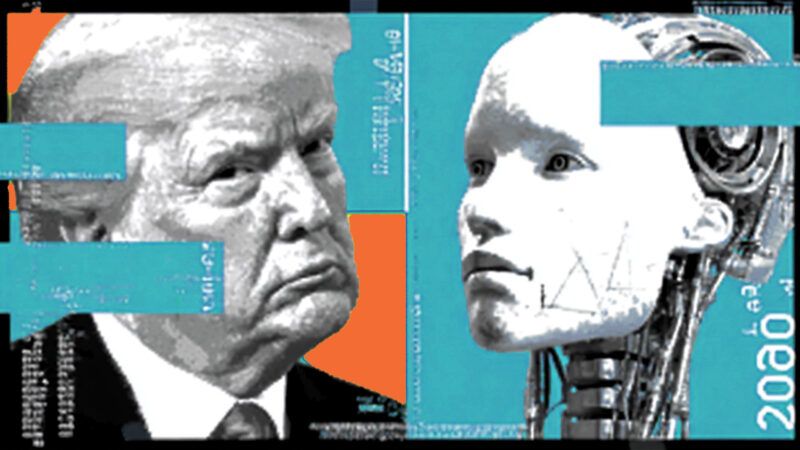Here's How the AI Action Plan Will Accelerate—and Throttle—AI Innovation
The American AI industry doesn't need industrial policy, just freedom.

President Donald Trump published his administration's AI Action Plan on Wednesday. Though much of the reporting following the announcement of the 28-page plan focuses on its accompanying executive order on "woke AI," the more important aspect of the plan is how it removes regulatory barriers to foster a friendly environment for American AI innovation.
The AI Action Plan is the product of Trump's January executive order calling for the removal of barriers to American leadership in AI. The plan begins with Trump taking AI seriously, referring to it as a transformative technology akin to space flight that has the "potential to reshape the global balance of power" and describes the AI revolution as "an industrial revolution, an information revolution, and a renaissance—all at once."
The plan presents three pillars to maintain America's "unquestioned and unchallenged global technological dominance": accelerate AI innovation; build American AI infrastructure; and lead in international AI diplomacy and security.
To accelerate AI innovation, the first thing the plan calls for is the removal of "red tape and onerous regulation" by directing federal agencies to withhold federal AI-related funding from states with "burdensome AI regulations that waste these funds." (This provision echoes the failed moratorium on the enforcement of state AI regulations that was removed from the Senate version of the One Big Beautiful Bill Act at the 11th hour.) The plan also directs the Office of Science and Technology Policy (OSTP) to submit a Request for Information to solicit feedback from the public to determine which federal regulations are stifling AI.
The most controversial and widely covered part of the plan is the president's insistence that American AI systems "be free from ideological bias…and social engineering agendas." Specifically, the plan directs the National Institute of Standards and Technology to remove references to "misinformation," "diversity, equity, and inclusion," and "climate change" from the AI Risk Management Framework implemented under the Biden administration. The plan also calls for the updating of federal procurement guidelines to prohibit agencies from using AI systems that are not "objective and free from top-down ideological bias." It remains unclear how this part of the order will affect the Pentagon's $200 million AI contracts with companies whose models are either openly biased, opaquely aligned, or a combination of the two.
Neil Chilson, head of AI policy at the Abundance Institute, explains that the executive order on preventing woke AI in the federal government "makes it clear that the 'Unbiased AI Principles' only apply to models procured by the government [which] solves most of the concerns everyone was worried about." Regarding AI alignment generally, Brendan Steinhauser, the CEO of The Alliance for Secure AI, tells Reason that he's "pleased to see the plan include a provision on launching a technology development program 'to advance interpretability, AI control systems, and adversarial robustness.'" However, Steinhauser is troubled by the plan's lack of mention of artificial general intelligence, artificial superintelligence, and the potential threat posed thereby.
While the plan's deregulatory agenda promotes AI innovation, its heavy-handed industrial policy will interfere with private investment and discourage productivity. The plan directs OSTP to publish a National AI Research and Development Strategic Plan "to guide Federal AI research investments." But there's no need for taxpayer dollars to be infused into the sector. Stanford University's Institute for Human-Centered Artificial Intelligence calculates that the private sector invested $109 billion in American AI, "nearly 12 times higher than China's $9.3 billion," in 2024; it is this private investment that is responsible for the industry's meteoric technological and economic growth.
The CHIPS and Science Act appropriated $53 billion to subsidize American tech businesses. The case of Intel is illustrative: Scott Lincicome, vice president of general economics at the Cato Institute, describes how the company was foundering for years before the Biden administration (unwisely) promised it $19 billion in corporate welfare in March 2024; Intel's stock fell so precipitously that year that Taiwan Semiconductor Manufacturing Co. considered purchasing the failing company this February. Trump recognized this failure on the campaign trail, but his AI Action Plan still invokes the statute to "invest in developing and scaling foundational and translational manufacturing technologies." The plan's direction of the Departments of Labor and Education to "prioritize AI skill development as a core objective of relevant education and workforce funding streams" is doomed for the same reason: Federal subsidies crowd out private funding, encourage bad investment, and discourage productivity.
While the AI Action Plan's revival of the federal moratorium on the enforcement of state AI regulation will kick AI innovation into high gear, its industrial policy will downshift it.


Show Comments (7)